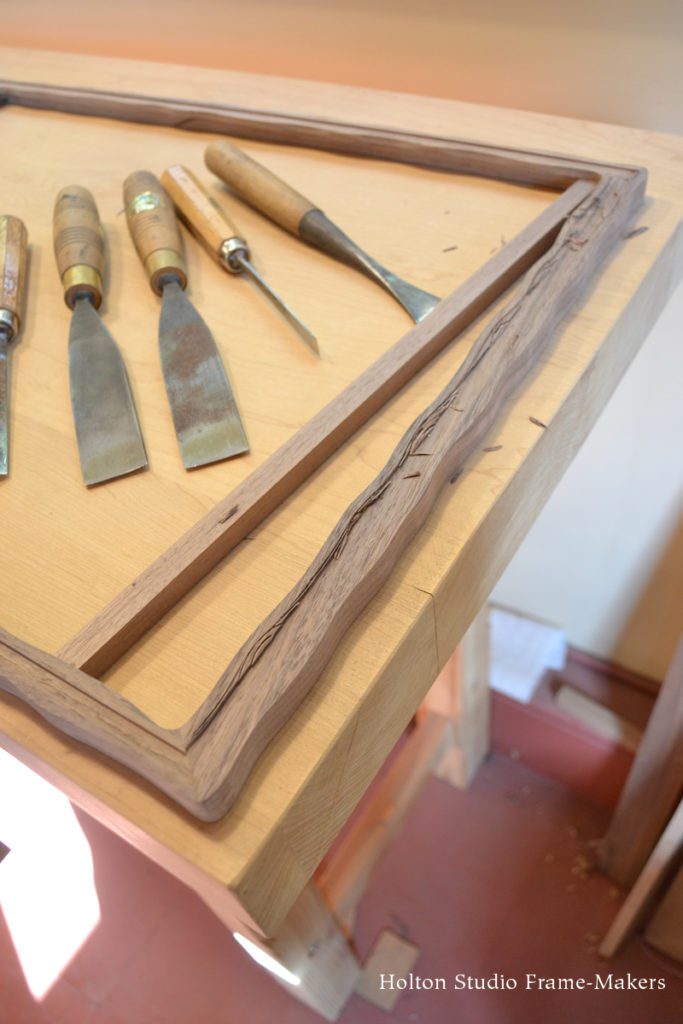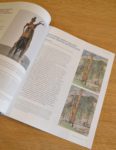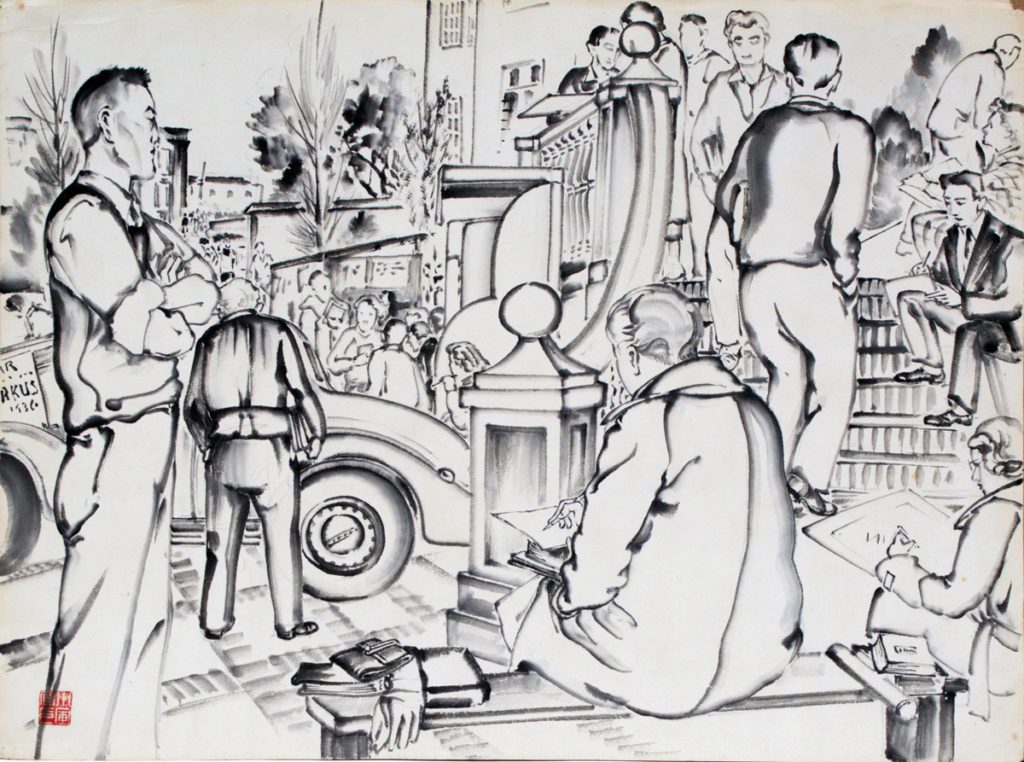This is a woodblock by Berkeley artist Chiura Obata (1885-1975), titled “Upper Lyell Fork, Near Lyell Glacier, High Sierra,” 16″ x 11″.  The carved frame, made in walnut with a black wash, is a variation on our No. 14 CV, a frame I like to use for woodblock prints because, with its raised lines and carved recess, it’s made exactly as are the woodblocks that produce such prints, and thus invariably enjoys a special harmony with the picture. This variation on the No. 14 CV is shaped to repeat the rendering of the old tree that’s the central subject. For the wavy edges, I used a drum sander to do that on the back and sight edges of each member, then carved the inside of each raised band parallel to the outside line (see process shot at right). In addition to the wavy sides, I played off the tree’s verticality by making the frame’s sides narrower (3/4″) than the top and bottom members (1″).
The carved frame, made in walnut with a black wash, is a variation on our No. 14 CV, a frame I like to use for woodblock prints because, with its raised lines and carved recess, it’s made exactly as are the woodblocks that produce such prints, and thus invariably enjoys a special harmony with the picture. This variation on the No. 14 CV is shaped to repeat the rendering of the old tree that’s the central subject. For the wavy edges, I used a drum sander to do that on the back and sight edges of each member, then carved the inside of each raised band parallel to the outside line (see process shot at right). In addition to the wavy sides, I played off the tree’s verticality by making the frame’s sides narrower (3/4″) than the top and bottom members (1″).
I used a plain 4-ply solid core rag mat matching the print’s tan paper, and Museum Glass (our most common choice for works behind glass; it’s both u.v.-filtering and glare-reducing).
 As it happens, Fine Arts Magazine, a publication of the Fine Arts Museums in San Francisco, recently wrote about the Museum’s acquisition of an Obata watercolor that served as the basis for this woodblock (another print of which they also have in their collection). According to the article,
As it happens, Fine Arts Magazine, a publication of the Fine Arts Museums in San Francisco, recently wrote about the Museum’s acquisition of an Obata watercolor that served as the basis for this woodblock (another print of which they also have in their collection). According to the article,
In the summer of 1927, Obata spent several weeks on a sketching tour of Yosemite, the Sierra high country, and the Bay Area foothills, producing more than one hundred sketches and ink paintings of the landscapes he encountered there. It’s likely that the three landscape drawings recently acquired for the Museums’ permanent collection were based on observations from those hiking trips.
They capture the essence of “Great Nature” that, Obata said, reinforced his belief in the insignificance of human pursuits in relation to the powerful forces of nature. The drawings, rich with calligraphic brushstrokes and washes of color, were preparatory works for a color woodcut project that he began in 1928 with the Takamizawa print workshop in Tokyo. This ambitious effort was grounded in ukiyo-e traditions in which Obata oversaw teams of carvers and printers who replicated his designs into color woodcut prints. The result, published in 1930, was an edition of portfolios of thirty-five prints each, titled World Landscape Series… Comparisons of the drawings with the prints reveal the incredible skill of the Japanese artisans who faithfully recreated Obata’s sophisticated designs.
Postscript
With UC Berkeley back in session in-person and the campus full of students again, I thought it fitting to include this 1930’s ink painting by Chiura Obata, who taught at the University from 1932 to 1954. (Another Obata ink painting we had the privilege of framing was featured in this post a couple of years ago.)

Chiura Obata, untitled (UC Berkeley students), ca. 1930’s. Ink on paper, 15-1/2″ x 20-3/4″.
Finally, a lovely bit of wisdom from the artist and teacher:
“You must always see with a big vision, and if you keep your mind calm there will be a way, there will be a light.”


